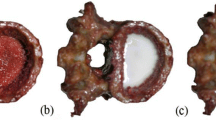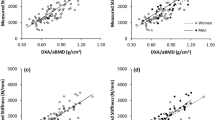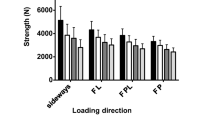Abstract
The aim of this study was to assess structural indices from high-resolution peripheral quantitative computed tomography (HR-pQCT) images of the human proximal femur along with areal bone mineral density (aBMD) and compare the relationship of these parameters to bone strength in vitro. Thirty-one human proximal femur specimens (8 men and 23 women, median age 74 years, range 50–89) were examined with HR-pQCT at four regions of interest (femoral head, neck, major and minor trochanter) with 82 μm and in a subgroup (n = 17) with 41 μm resolution. Separate analyses of cortical and trabecular geometry, volumetric BMD (vBMD), and microarchitectural parameters were obtained. In addition, aBMD by dual-energy X-ray absorptiometry (DXA) was performed at conventional hip regions and maximal compressive strength (MCS) was determined in a side-impact biomechanical test. Twelve cervical and 19 trochanteric fractures were confirmed. Geometry, vBMD, microarchitecture, and aBMD correlated significantly with MCS, with Spearman’s correlation coefficients up to 0.77, 0.89, 0.90, and 0.85 (P < 0.001), respectively. No differences in these correlations were found using 41 μm compared to 82 μm resolution. In multiple regression analysis of MCS, a combined model (age- and sex-adjusted) with aBMD and structural parameters significantly increased R 2 values (up to 0.90) compared to a model holding aBMD alone (R 2 up to 0.78) (P < 0.05). Structural parameters and aBMD are equally related to MCS, and both cortical and trabecular structural parameters obtained from HR-pQCT images hold information on bone strength complementary to that of aBMD.




Similar content being viewed by others
References
Vestergaard P, Rejnmark L, Mosekilde L (2007) Increased mortality in patients with a hip fracture—effect of pre-morbid conditions and post-fracture complications. Osteoporos Int 18:1583–1593
Burge R, Dawson-Hughes B, Solomon DH, Wong JB, King A, Tosteson A (2007) Incidence and economic burden of osteoporosis-related fractures in the United States, 2005–2025. J Bone Miner Res 22:465–475
Ammann P, Rizzoli R (2003) Bone strength and its determinants. Osteoporos Int 14(Suppl 3):S13–S18
Wainwright SA, Marshall LM, Ensrud KE, Cauley JA, Black DM, Hillier TA, Hochberg MC, Vogt MT, Orwoll ES (2005) Hip fracture in women without osteoporosis. J Clin Endocrinol Metab 90:2787–2793
Kanis JA, Johnell O, Oden A, Dawson A, De LC, Jonsson B (2001) Ten year probabilities of osteoporotic fractures according to BMD and diagnostic thresholds. Osteoporos Int 12:989–995
Link TM, Vieth V, Langenberg R, Meier N, Lotter A, Newitt D, Majumdar S (2003) Structure analysis of high resolution magnetic resonance imaging of the proximal femur: in vitro correlation with biomechanical strength and BMD. Calcif Tissue Int 72:156–165
Baum T, Carballido-Gamio J, Huber MB, Muller D, Monetti R, Rath C, Eckstein F, Lochmuller EM, Majumdar S, Rummeny EJ, Link TM, Bauer JS (2010) Automated 3D trabecular bone structure analysis of the proximal femur—prediction of biomechanical strength by CT and DXA. Osteoporos Int 21:1553–1564
Bauer JS, Kohlmann S, Eckstein F, Mueller D, Lochmuller EM, Link TM (2006) Structural analysis of trabecular bone of the proximal femur using multislice computed tomography: a comparison with dual X-ray absorptiometry for predicting biomechanical strength in vitro. Calcif Tissue Int 78:78–89
Lang TF, Keyak JH, Heitz MW, Augat P, Lu Y, Mathur A, Genant HK (1997) Volumetric quantitative computed tomography of the proximal femur: precision and relation to bone strength. Bone 21:101–108
Bousson V, Le BA, Roqueplan F, Kang Y, Mitton D, Kolta S, Bergot C, Skalli W, Vicaut E, Kalender W, Engelke K, Laredo JD (2006) Volumetric quantitative computed tomography of the proximal femur: relationships linking geometric and densitometric variables to bone strength. Role for compact bone. Osteoporos Int 17:855–864
Manske SL, Liu-Ambrose T, de Bakker PM, Liu D, Kontulainen S, Guy P, Oxland TR, McKay HA (2006) Femoral neck cortical geometry measured with magnetic resonance imaging is associated with proximal femur strength. Osteoporos Int 17:1539–1545
Manske SL, Liu-Ambrose T, Cooper DM, Kontulainen S, Guy P, Forster BB, McKay HA (2009) Cortical and trabecular bone in the femoral neck both contribute to proximal femur failure load prediction. Osteoporos Int 20:445–453
Cheng XG, Lowet G, Boonen S, Nicholson PH, Brys P, Nijs J, Dequeker J (1997) Assessment of the strength of proximal femur in vitro: relationship to femoral bone mineral density and femoral geometry. Bone 20:213–218
Eckstein F, Matsuura M, Kuhn V, Priemel M, Muller R, Link TM, Lochmuller EM (2007) Sex differences of human trabecular bone microstructure in aging are site-dependent. J Bone Miner Res 22:817–824
Link TM, Vieth V, Stehling C, Lotter A, Beer A, Newitt D, Majumdar S (2003) High-resolution MRI vs multislice spiral CT: Which technique depicts the trabecular bone structure best? Eur Radiol 13:663–671
Bauer JS, Link TM (2009) Advances in osteoporosis imaging. Eur J Radiol 71:440–449
Hildebrand T, Ruegsegger P (1997) A new method for the model independent assessment of thickness in three-dimensional images. J Microsc 185:67–75
Laib A, Hildebrand T, Hauselmann HJ, Ruegsegger P (1997) Ridge number density: a new parameter for in vivo bone structure analysis. Bone 21:541–546
Laib A, Ruegsegger P (1999) Calibration of trabecular bone structure measurements of in vivo three-dimensional peripheral quantitative computed tomography with 28-micron-resolution microcomputed tomography. Bone 24:35–39
MacNeil JA, Boyd SK (2007) Accuracy of high-resolution peripheral quantitative computed tomography for measurement of bone quality. Med Eng Phys 29:1096–1105
Buie HR, Campbell GM, Klinck RJ, MacNeil JA, Boyd SK (2007) Automatic segmentation of cortical and trabecular compartments based on a dual threshold technique for in vivo micro-CT bone analysis. Bone 41:505–515
Nielsen SP, Slosman D, Sorensen OH, Basse-Cathalinat B, De CP, Roux CR, Meunier PJ (1999) Influence of strontium on bone mineral density and bone mineral content measurements by dual X-ray absorptiometry. J Clin Densitom 2:371–379
Beck TJ, Ruff CB, Warden KE, Scott WW Jr, Rao GU (1990) Predicting femoral neck strength from bone mineral data. A structural approach. Investig Radiol 25:6–18
Mayhew PM, Thomas CD, Clement JG, Loveridge N, Beck TJ, Bonfield W, Burgoyne CJ, Reeve J (2005) Relation between age, femoral neck cortical stability, and hip fracture risk. Lancet 366:129–135
Verhulp E, Van RB, Huiskes R (2008) Load distribution in the healthy and osteoporotic human proximal femur during a fall to the side. Bone 42:30–35
de Bakker PM, Manske SL, Ebacher V, Oxland TR, Cripton PA, Guy P (2009) During sideways falls proximal femur fractures initiate in the superolateral cortex: evidence from high-speed video of simulated fractures. J Biomech 42:1917–1925
Bouxsein ML, Fajardo RJ (2005) Cortical stability of the femoral neck and hip fracture risk. Lancet 366:1523–1524
Turner CH (2005) The biomechanics of hip fracture. Lancet 366:98–99
Sugiyama T, Taguchi T (2005) Cortical stability of the femoral neck and hip fracture risk. Lancet 366:1525–1526
Zebaze RM, Seeman E (2005) Cortical stability of the femoral neck and hip fracture risk. Lancet 366:1523–1525
Wachter NJ, Augat P, Mentzel M, Sarkar MR, Krischak GD, Kinzl L, Claes LE (2001) Predictive value of bone mineral density and morphology determined by peripheral quantitative computed tomography for cancellous bone strength of the proximal femur. Bone 28:133–139
Link TM, Majumdar S, Lin JC, Newitt D, Augat P, Ouyang X, Mathur A, Genant HK (1998) A comparative study of trabecular bone properties in the spine and femur using high resolution MRI and CT. J Bone Miner Res 13:122–132
Cody DD, McCubbrey DA, Divine GW, Gross GJ, Goldstein SA (1996) Predictive value of proximal femoral bone densitometry in determining local orthogonal material properties. J Biomech 29:753–761
Huber MB, Carballido-Gamio J, Bauer JS, Baum T, Eckstein F, Lochmuller EM, Majumdar S, Link TM (2008) Proximal femur specimens: automated 3D trabecular bone mineral density analysis at multidetector CT—correlation with biomechanical strength measurement. Radiology 247:472–481
Black DM, Bouxsein ML, Marshall LM, Cummings SR, Lang TF, Cauley JA, Ensrud KE, Nielson CM, Orwoll ES (2008) Proximal femoral structure and the prediction of hip fracture in men: a large prospective study using QCT. J Bone Miner Res 23:1326–1333
Johannesdottir F, Poole KE, Reeve J, Siggeirsdottir K, Aspelund T, Mogensen B, Jonsson BY, Sigurdsson S, Harris TB, Gudnason VG, Sigurdsson G (2011) Distribution of cortical bone in the femoral neck and hip fracture: a prospective case–control analysis of 143 incident hip fractures; the AGES-REYKJAVIK Study. Bone 48:1268–1276
Courtney AC, Wachtel EF, Myers ER, Hayes WC (1994) Effects of loading rate on strength of the proximal femur. Calcif Tissue Int 55:53–58
Yang KH, Shen KL, Demetropoulos CK, King AI, Kolodziej P, Levine RS, Fitzgerald RH Jr (1996) The relationship between loading conditions and fracture patterns of the proximal femur. J Biomech Eng 118:575–578
Pinilla TP, Boardman KC, Bouxsein ML, Myers ER, Hayes WC (1996) Impact direction from a fall influences the failure load of the proximal femur as much as age-related bone loss. Calcif Tissue Int 58:231–235
Cody DD, Gross GJ, Hou FJ, Spencer HJ, Goldstein SA, Fyhrie DP (1999) Femoral strength is better predicted by finite element models than QCT and DXA. J Biomech 32:1013–1020
Li W, Kornak J, Harris T, Keyak J, Li C, Lu Y, Cheng X, Lang T (2009) Identify fracture-critical regions inside the proximal femur using statistical parametric mapping. Bone 44:596–602
Acknowledgments
This work was partially supported by grants from the PhD School of Endocrinology (University of Southern Denmark) and the Region of Southern Denmark. Thanks to Elizabeth Hanmann for performing DXA scans and to Claire Gudex for proofreading and language help.
Author information
Authors and Affiliations
Corresponding author
Additional information
The authors have stated that they have no conflict of interest.
Electronic supplementary material
Below is the link to the electronic supplementary material.
Rights and permissions
About this article
Cite this article
Hansen, S., Jensen, JE.B., Ahrberg, F. et al. The Combination of Structural Parameters and Areal Bone Mineral Density Improves Relation to Proximal Femur Strength: An In Vitro Study with High-Resolution Peripheral Quantitative Computed Tomography. Calcif Tissue Int 89, 335–346 (2011). https://doi.org/10.1007/s00223-011-9523-z
Received:
Accepted:
Published:
Issue Date:
DOI: https://doi.org/10.1007/s00223-011-9523-z




